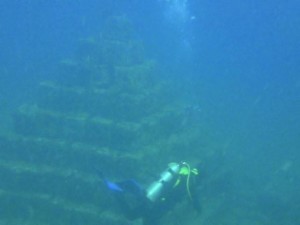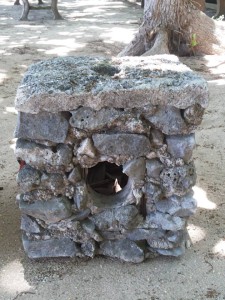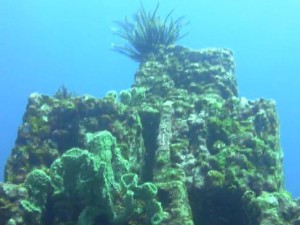

By commercial definition, Calatagan in Batangas is not a dive destination; and its chain of underwater pyramids is not a “dive site.” There are no dive centers nearby. No accessible source of air tanks and gears for rent. No experienced dive guides and boatmen who know where creatures lounge, eat and sleep at specific times of the day.
But, if you’re a diver or a brave snorkeler, you must see the underwater pyramids at least once in your life. Not for the sea creatures and fauna that inhabit its waters. Growth/regrowth of marine life around an artificial reef takes a long time and it’s just been a little more than 5 years for the pyramids.
Go to the pyramids to see the output of millions of pesos in private funding, and years of dive volunteerism. Go to see the renewed commitment to marine conservation by a community that has felt the effects of their illegal fishing practices.
Go so you’ll see a majestic testament to what can be accomplished when government and non-government organizations cooperate with private individuals to save a dying ocean.
The Underwater Pyramids of the Philippines

The Underwater Pyramids of Calatagan is a chain of pyramid-shaped artificial reefs that snake a small area around 200 feet from the shore, at about 60 ft. depth. Each pyramid rises up to 18 feet, and is made of rock/dead coral blocks that weigh around 80 kilos each.
It took years to put the pyramids together. CAP (Conserve and Protect) Oceans, a now-defunct NGO, was at the center of it. It led a community initiative to establish an artificial reef within Calatagan’s abused waters. Years before, dynamite fishing was rampant and eventually took toll. Fish harvest declined; coral reefs were destroyed. An artificial reef was the centerpiece of the fight against illegal fishing. This was supported by barangay leaders and most members of the community.
Dive volunteers came mostly during the weekends to help out. In the years it took to complete the pyramids, their number reached more than 1,500. They were housed for free at the base camp, the annex to the home of the pyramid’s reclusive benefactor, the recently departed Vicente Madrigal Warns.
It was Warns who thought of designing the reefs after the Egyptian architectural wonder. They initially used cement blocks the size of refrigerators, which were eventually buried by sand and had zero growth even after several months. Warns thought that patterning the reef after the pyramids will not only channel their timelessness but also withstand the restive nature of the sea.
To Reef or Not to Reef

The establishment of artificial reefs has been practiced since the 1600s (Japan) and is generally an acceptable way of allowing the ocean to renew itself. Artificial reefs function mainly as fish shelter. They also attract smaller organisms that are food for fish, thereby increasing fish count within the location.
Of course, it doesn’t come without criticisms and some disadvantages. The success of an artificial reef is dependent on its material, location and water movement. And, despite good intentions, in certain cases they might do more harm than good.
The Osborne Reef in Fort Lauderdale, Florida is a good example of an artificial reef gone bad. In the 1970s, the reef project was expanded using 2 million used tires held together using nylon or steel clasps. The steel clasps eventually gave in to time and ferocious storms. Tires went loose and polluted the waters of the Florida Panhandle and North Carolina beaches. Massive cleanups were necessarily undertaken. Tire reef projects in Indonesia and Malaysia suffered the same fate.
Majesty Under the Sea
Fortunately, the Underwater Pyramids of Calatagan is a success, so far. It has survived countless storms, the ocean’s movement and the passing of its benefactor.
This video was take in June 2014 and showed impressive growth since I dove the same site 5 years ago.
However, there are real threats to the pyramids surviving a few years more. Several blocks of the highest pyramid (video above) were destroyed by a few local fishermen for fish that have taken shelter within them. There is also a revival of illegal fishing in some parts. All while CAP Oceans — because of Warn’s passing — has lost its teeth. There are no available means of running after perpetrators, no operating facility to house and equip volunteers, and no funds to empower Bantay Dagat efforts.
Marine conservation — even with artificial reefs already established — is a continuing effort, after all.
At this point, the Underwater Pyramids of Calatagan needs the renewed support of the diving community. Calatagan no longer offers the cushy perks of a Warn’s supported project — no free lodging nor equipment. But it can give you a dive experience that’s unique and truly awe-inspiring.
Maybe, through this kind of diver support, the community can see an earning alternative, something to rekindle their interest in being the site of the Philippines’ majestic Underwater Pyramids.
***
Want to dive the pyramids? Contact Calatagan Reef Ranger Jessie Delos Reyes: mangingisda_1976 (at) yahoo (dot) com (dot) ph.
Sources:
An overview of Artificial Reefs, Advantages and Disadvantages of Artificial Reefs Design, Material and Concepts of Realization around the Globe by Maricela Yip
Should we create artificial reefs? by Neville Copperthwaite
Osborne Reef, Wikipedia
